The Plasma Powder Market is estimated to be valued at USD 3.3 billion in 2025 and is projected to reach USD 5.4 billion by 2035, registering a compound annual growth rate (CAGR) of 5.2% over the forecast period.
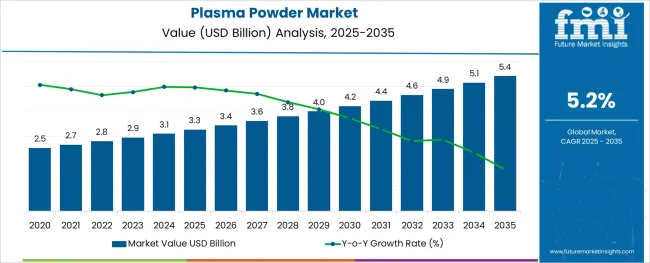
The plasma powder market is advancing steadily as demand increases for high-value animal protein ingredients used in functional feed and pet food formulations. With the intensification of livestock production and focus on early-stage animal health, plasma powder has gained recognition for its ability to enhance immunity, gut development, and feed conversion ratios.
Manufacturers are expanding capacity and adopting advanced spray-drying technologies to ensure bioactive protein preservation and pathogen control. Regulatory acceptance in developed markets, along with growing interest in antibiotic alternatives, is driving adoption in swine, poultry, aquaculture, and companion animal feed. Strategic collaborations among feed integrators, veterinary researchers, and rendering companies are improving product availability and formulation precision.
As sustainability and waste valorization gain importance in the protein supply chain, plasma powder is positioned to benefit from circular economy models that turn abattoir by-products into valuable nutritional inputs. Future growth is expected to be fueled by diversification into pet food, enhanced traceability, and region-specific dietary formulations aligned with performance-driven animal nutrition programs.
The market is segmented by Source and Application and region. By Source, the market is divided into Bovine, Porcine, and Others. In terms of Application, the market is classified into Swine Feed, Food, Pharmaceuticals, and Others (Application). Regionally, the market is classified into North America, Latin America, Western Europe, Eastern Europe, Balkan & Baltic Countries, Russia & Belarus, Central Asia, East Asia, South Asia & Pacific, and the Middle East & Africa.
The market is segmented by Source and Application and region. By Source, the market is divided into Bovine, Porcine, and Others. In terms of Application, the market is classified into Swine Feed, Food, Pharmaceuticals, and Others (Application). Regionally, the market is classified into North America, Latin America, Western Europe, Eastern Europe, Balkan & Baltic Countries, Russia & Belarus, Central Asia, East Asia, South Asia & Pacific, and the Middle East & Africa.
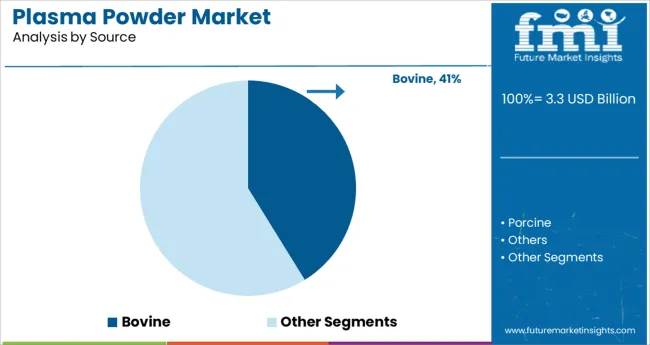
The bovine segment is projected to account for 41.2% of revenue share in the source category by 2025, marking it as the leading segment in the plasma powder market. This dominance is attributed to bovine plasma’s high functional protein content and bioavailability, which make it a preferred choice in both livestock and pet nutrition applications.
The availability of bovine blood from the beef processing industry has ensured consistent raw material supply, supporting scalable production and cost efficiency. Moreover, advancements in fractionation and sterilization technologies have enhanced the safety and nutritional integrity of bovine-derived plasma, fostering its use in high-specification feed blends.
Bovine plasma has also demonstrated effective performance in improving immune function and post-weaning growth in young animals, particularly in species with higher dietary protein demands. The segment’s growth has been further reinforced by its compatibility with regulatory frameworks across North America and Europe, ensuring sustained market preference.
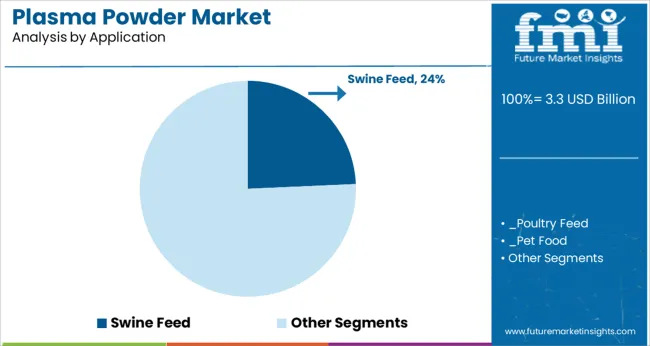
Swine feed is anticipated to contribute 24.3% of total revenue share by 2025 within the application category, emerging as the leading application area in the plasma powder market. This leadership stems from plasma powder’s proven benefits in piglet diets, particularly during the critical weaning phase when intestinal health and immunity are most vulnerable.
The inclusion of plasma powder in starter feed formulations has been associated with improved feed intake, better weight gain, and reduced morbidity rates. These functional advantages have driven swine producers to prioritize plasma as a cost-effective solution for maintaining productivity in antibiotic-restricted systems.
In addition, increasing concerns around antimicrobial resistance have accelerated the shift toward functional proteins like plasma as natural performance enhancers. Feed manufacturers are customizing plasma inclusion rates to optimize early growth and digestive health in swine, ensuring its continued relevance in performance-oriented feeding programs. The economic and biological return from plasma supplementation has anchored its position as a vital input in modern swine nutrition.
The high demand for animal-derived food products like fish, eggs, meat, and milk is creating an urgent need to provide more nourishment to animals. Optimization of poultry farm infrastructure, enhancements in animal welfare, and ongoing technological developments are expected to push the poultry sector in the next decade.
As feed is considered to be the most critical component in ensuring the supply of abundant, healthy, and affordable animal proteins, animal feed plays a crucial role in the global food economy. Good amounts of nutrients are needed by livestock to meet the requirements of distinct growth stages. They require proper nourishment for organ, muscle, and bone growth and development.
Plasma powder is capable of enhancing gut health and feed palatability. Increasing the use of spray-dried plasma powder as an in-feed alternative to zinc oxide and prophylactic antibiotics is anticipated to bolster growth in the market.
Highly digestible proteins or plasma proteins are becoming increasingly crucial in livestock farming as undigested proteins in the gut of animals can cause bacterial fermentation and pathogen overgrowth.
Plasma powder can improve the overall performance and mortality of livestock. The product contains antibodies and other bioactive compounds that enable passive mucosal immunity against viral and bacterial infections.
Immunoglobulin G and plasma-borne growth factors in plasma powder also promote gut maturation and reinforce the intestinal barrier. Plasma is regarded as an irreversible gelling agent that improves the chunk texture and overall palatability of wet pet food, in addition to its health-promoting characteristics. Therefore, the animal feed industry is expected to push demand for plasma powder in the evaluation period.
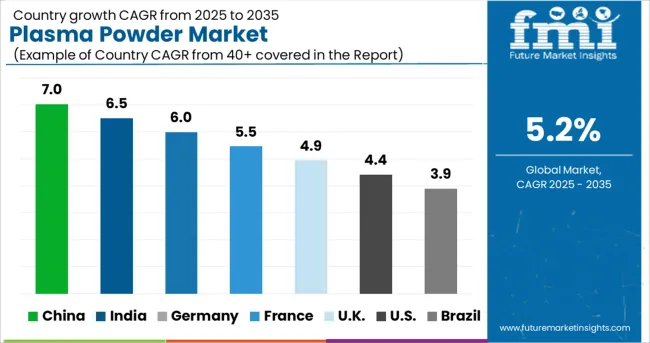
The USA Plasma Powder Market to Benefit from Increasing Number of Pet Owners in the Country
During the projected period, the USA is expected to dominate the North American plasma powder market owing to the presence of a large number of pet owners in the country. Also, a growing trend among livestock farmers to seek out new alternatives to antimicrobial growth promoters (AMGPs) would aid growth.
As per FMI, the USA plasma powder market is expected to reach USD 3.3 Billion in 2025 and is set to be valued at USD 5.4 Billion in 2035.
Baked Goods Manufacturers to Create High Demand for Plasma Powder Coatings
Due to the rising consumption of bread and processed foods in Germany, the plasma powder market is expected to increase rapidly in the forecast period from 2025 to 2035. Rising consumer preference for baked goods on the back of their low calorie and high protein content, as well as pleasant taste, is also expected to propel growth in Germany.
Plasma Powders & Systems to Be Used as an Egg Alternative
Increasing use of plasma powder as a relatively low-cost alternative to eggs in baked goods and confectioneries across Mexico is anticipated to fuel the market. High demand for convenient, ready-to-eat food products as a result of rapidly changing lifestyles and the adoption of hectic schedules by consumers would also stimulate demand in the country.
Bovine Plasma Powder Coatings to Gain Traction
By source, the bovine segment is expected to create an absolute opportunity of USD 3.3 Billion in 2025, finds FMI. The segment is projected to grow significantly over the next few years.
In the food processing sector, bovine plasma is extensively utilized as an emulsifier and fat replacer. Rising export and import of processed food items, as well as the rapid expansion of the processed food industry, would bode well for the segment.
Besides, the use of bovine plasma is expected to reduce pollution and prevent the loss of a valuable protein source, thereby resulting in greater earnings and environmental benefits that would help the market to flourish.
Pharmaceutical Industry to Adopt Plasma Powders & Systems
The introduction of novel plasma-derived medicines is propelling the pharmaceutical segment forward. In addition, the rising incidence of genetic illnesses is likely to encourage healthcare professionals to use plasma-derived medications for treatment.
Over the last two decades, there has been a surging demand for tailored medicines, as well as a growing preference for early disease identification. These factors are expected to favorably influence the segment in the global market.
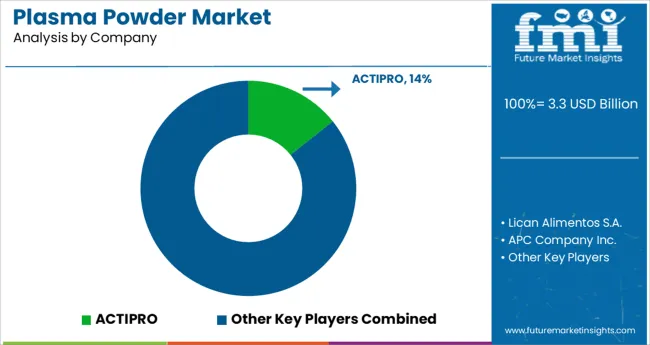
To address the high demand for plasma powder-infused products from various industries, key companies are concentrating on producing novel and highly effective plasma powder. They are expected to create new plasma powders from diverse animal sources for providing high levels of animal protein for a wide range of food and feed applications.
Some of the other key players are also focusing on increasing their market presence through mergers and acquisitions, as well as opening new manufacturing units in numerous locations to generate high shares.
For instance,
| Attributes | Details |
|---|---|
| Estimated Market Size (2025) | USD 2.8 Billion |
| Projected Market Valuation (2035) | USD 3.0 Billion |
| Value-based CAGR (2025 to 2035) | 5.2% |
| Forecast Period | 2025 to 2035 |
| Historical Data Available for | 2020 to 2024 |
| Market Analysis | Value (billion) and Volume (MT) |
| Key Regions Covered | North America; Latin America; Europe; Asia Pacific; and the Middle East and Africa |
| Key Countries Covered | United States of America, Canada, Mexico, Germany, France, Russia, United Kingdom, Italy, Spain, China, India, Japan, South Korea, Thailand, Vietnam, Indonesia, Australia, Brazil, South Africa, Saudi Arabia, and Egypt. |
| Key Segments Covered | Source, Application, and Region |
| Key Companies Profiled | ACTIPRO; Lican Alimentos S.A.; APC Company Inc.; Merck KGaA; Rocky Mountain Biologicals LLC; Veos N.V.; Darling Ingredients Inc. (Sonac); Acontex GmbH; SARIA Group; Shenzhen Tier |
| Report Coverage | Market forecast, company share analysis, competition intelligence, Drivers, Restraints, Opportunities and Threats analysis, market dynamics and challenges, and strategic growth initiatives |
The global plasma powder market is estimated to be valued at USD 3.3 billion in 2025.
It is projected to reach USD 5.4 billion by 2035.
The market is expected to grow at a 5.2% CAGR between 2025 and 2035.
The key product types are bovine, porcine and others.
swine feed segment is expected to dominate with a 24.3% industry share in 2025.






Full Research Suite comprises of:
Market outlook & trends analysis
Interviews & case studies
Strategic recommendations
Vendor profiles & capabilities analysis
5-year forecasts
8 regions and 60+ country-level data splits
Market segment data splits
12 months of continuous data updates
DELIVERED AS:
PDF EXCEL ONLINE
Plasma Dynamic Air Sterilizer Market Size and Share Forecast Outlook 2025 to 2035
Plasma Cutting Machine Market Size and Share Forecast Outlook 2025 to 2035
Plasma Bottle Market Size and Share Forecast Outlook 2025 to 2035
Plasma Separation Tubes Market Trends – Demand & Forecast 2025 to 2035
Competitive Overview of Plasma Bottle Industry Share
Plasma-Derived Drugs Market
Plasma Protein System Market
Plasma-derived Protein Therapies Market
Plasma Lighting Market
RF Plasma Generators Market
CNC Plasma Cutting Machines Market Size and Share Forecast Outlook 2025 to 2035
Mycoplasma Plate Antigens Market Size and Share Forecast Outlook 2025 to 2035
Cold Plasma Market – Growth, Demand & Forecast 2025 to 2035
Rapid Plasma Reagin Test Market
Remote Plasma Source Market
Arc-based Plasma Lighting Market Size and Share Forecast Outlook 2025 to 2035
Platelet Rich Plasma Market Analysis - Size, Share, and Forecast Outlook 2025 to 2035
Specialty Control Plasma Market - Demand & Forecast 2025 to 2035
Spray-dried Animal Plasma (SDAP) Market Size and Share Forecast Outlook 2025 to 2035
Europe Platelet Rich Plasma (PRP) Market Growth – Trends & Forecast 2025 to 2035

Thank you!
You will receive an email from our Business Development Manager. Please be sure to check your SPAM/JUNK folder too.
Chat With
MaRIA